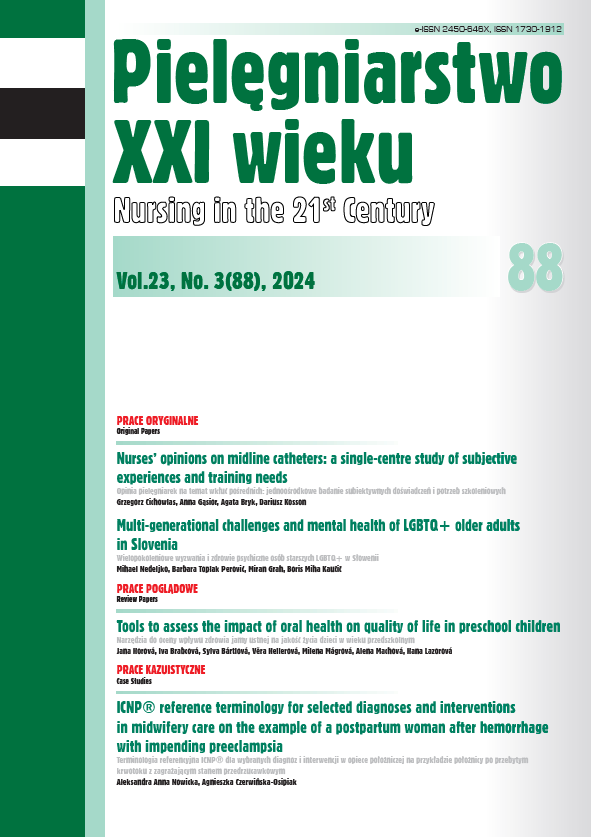Patient needs, functional requirements, aesthetic preferences and barriers in app-based therapy for knee osteoarthritis
DOI:
https://doi.org/10.2478/pielxxiw-2024-0026Keywords:
perceptions, patients, application, physiotherapy, knee osteoarthritisAbstract
PATIENT NEEDS, FUNCTIONAL REQUIREMENTS, AESTHETIC PREFERENCES AND BARRIERS IN APP-BASED THERAPY FOR KNEE OSTEOARTHRITIS
Introduction. Knee osteoarthritis (KOA) is an infl ammatory condition aff ecting over 25% of adults. Web/mobile technology off ers potential benefi ts in the treatment of KOA by improving access to care and reducing costs by utilising mobile devices for medical care and patient education.
Aim. The study aims to answer the question of what needs, functional requirements and aesthetic preferences patients with knee osteoarthritis have and what barriers and facilitators there are when using an app-based therapy.
Material and methods. We used a qualitative research design with in-depth interviews with 20 patients.
Results and conclusion. Interviewees emphasized that effective KOA management apps must address diverse patient needs, ensure accessibility, offer customizable features, provide comprehensive information and self-management tools, support pain relief, enable remote monitoring, integrate with support communities, and be cost-efficient. These apps should combine functional requirements, such as a simple user interface, integration with wearable devices, educational content, exercise guidance, pain management tools, remote consultations, community support, and feedback mechanisms, with aesthetic preferences for clear, accessible design, large fonts, high-contrast colours, suitable interactive elements, consistent layout, guiding animations, and accessibility features like text resizing, voice commands, and audio descriptions. In conclusion, this study underscores the necessity for KOA management apps to integrate diverse functional requirements and aesthetic preferences, ensuring accessibility, customization, comprehensive information, and support features to enhance usability, effectiveness, and patient satisfaction.
References
1. Leifer VP, Katz JN, Losina E. The burden of OA-health services and economics. Osteoarthritis and cartilage. 2022; 30(1):10-16. doi:10.1016/j.joca.2021.05.007
2. World Health Organization. mHealth: New Horizons for Health through Mobile Technologies. Geneva: WHO Press; 2011.
3. Xiang W, Wang J-Y, Ji B-J, et al. Effectiveness of Different Telerehabilitation Strategies on Pain and Physical Function in Patients With Knee Osteoarthritis: Systematic Review and Meta-Analysis. Journal of medical Internet research. 2023; 25(1). doi:10.2196/40735
4. Choi W, Zheng H, Franklin P, et al. mHealth technologies for osteoarthritis self-management and treatment: A systematic review. Health informatics journal. 2019; 25(3): 984-1003. doi:10.1177/1460458217735676
5. Safari R, Jackson J, Sheffield D. Digital self-management interventions for people with osteoarthritis: Systematic review with meta-analysis. Journal of medical Internet research. 2020; 22(7): 0-24. doi:10.2196/15365
6. McHugh CG, Kostic AM, Katz JN, et al. Effectiveness of remote exercise programs in reducing pain for patients with knee osteoarthritis: A systematic review of randomized trials. Osteoarthritis and cartilage open. 2022; 4(3): 100264. doi:10.1016/j.ocarto.2022.100264
7. Shah N, Costello K, Mehta A, et al. Applications of Digital Health Technologies in Knee Osteoarthritis: Narrative Review. JMIR rehabilitation and assistive technologies. 2022; 9(2). doi:10.2196/33489
8. Marcolino MS, Oliveira JAQ, D’Agostino M, et al. The impact of mHealth interventions: Systematic review of systematic reviews. JMIR mHealth and uHealth. 2018; 20(1). doi:10.2196/mhealth.8873
9. Barber T, Sharif B, Teare S, et al. Qualitative study to elicit patients’ and primary care physicians’ perspectives on the use of a self-management mobile health application for knee osteoarthritis. BMJ open. 2019;9(1):0-8. doi:10.1136/bmjopen-2018-024016
10. Mrklas KJ, Barber T, Campbell-Scherer D. Co-design in the development of a mobile health app for the management of knee osteoarthritis by patients and physicians. JMIR mHealth and uHealth. 2020; 8(7): 0-15. doi:10.2196/17893
11. Biebl JT, Huber S, Rykala M, et al. Attitudes and expectations of health care professionals toward app-based therapy in patients with osteoarthritis of the hip or knee: Questionnaire study. JMIR mHealth and uHealth. 2020; 8(10): 0-12. doi:10.2196/21704
12. Braun V, Clarke V. Conceptual and design thinking for thematic analysis. Qual Psychol. 2022;9(1):3-26. doi:10.1037/qup0000196
13. Zayim N, Yıldız H, Yüce YK. Estimating cognitive load in a mobile personal health record application: A cognitive task analysis approach. Healthc. Inform Res. 2023; 29(4): 367. doi: 10.1017/S146342362100058X
14. Bombard Y, Baker GR, Orlando E, et al. Engaging patients to improve quality of care: a systematic review. Implement Sci. 2018; 13(1): 98. Published 2018 Jul 26. doi:10.1186/s13012-018-0784-z
15. Lorig KR, Ritter PL, Laurent DD, et al. Internet-based chronic disease self-management: a randomized trial. Med Care. 2006 Nov; 44(11): 964-971. doi: 10.1097/01.mlr.0000233678.80203.c1.
16. Chiauzzi, E, Rodarte C, DasMahapatra P. Patient-centered activity monitoring in the self-management of chronic health conditions. BMC Med. 2015;13, 77. doi: 10.1186/s12916-015-0319-2
17. Krebs P, Duncan DT. Health App Use Among US Mobile Phone Owners: A National Survey. JMIR Mhealth Uhealth. 2015; 3(4): e101. doi: 10.2196/mhealth.4924.
18. Norman DA, Draper SW. User Centered System Design: New Perspectives on Human-Computer Interaction. CRC Press; 1986.
19. World Health Organization. WHO Guidelines on Design and Implementation of Digital Health Interventions. World Health Organization; 2011.
Downloads
Published
Issue
Section
License
Copyright (c) 2024 Authors

This work is licensed under a Creative Commons Attribution 4.0 International License.




